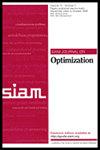通过长步骤实现更快的梯度下降
IF 2.3
1区 数学
Q1 MATHEMATICS, APPLIED
引用次数: 0
摘要
SIAM 优化期刊》,第 34 卷第 3 期,第 2588-2608 页,2024 年 9 月。 摘要本文通过计算机辅助分析技术为平滑凸优化中的梯度下降建立了新的收敛保证。我们的理论通过一次性分析多次迭代的整体效果,而不是大多数一阶方法分析中使用的典型的一次迭代归纳,允许非恒定步长的策略频繁出现可能违反下降的长步长。我们证明,长步长可能会在短期内增加目标值,但却能在长期内加快收敛速度。我们还提出了梯度下降法更快[数学]收敛速度的猜想,并进行了简单的数值验证。本文章由计算机程序翻译,如有差异,请以英文原文为准。
Provably Faster Gradient Descent via Long Steps
SIAM Journal on Optimization, Volume 34, Issue 3, Page 2588-2608, September 2024.
Abstract. This work establishes new convergence guarantees for gradient descent in smooth convex optimization via a computer-assisted analysis technique. Our theory allows nonconstant stepsize policies with frequent long steps potentially violating descent by analyzing the overall effect of many iterations at once rather than the typical one-iteration inductions used in most first-order method analyses. We show that long steps, which may increase the objective value in the short term, lead to provably faster convergence in the long term. A conjecture towards proving a faster [math] rate for gradient descent is also motivated along with simple numerical validation.
Abstract. This work establishes new convergence guarantees for gradient descent in smooth convex optimization via a computer-assisted analysis technique. Our theory allows nonconstant stepsize policies with frequent long steps potentially violating descent by analyzing the overall effect of many iterations at once rather than the typical one-iteration inductions used in most first-order method analyses. We show that long steps, which may increase the objective value in the short term, lead to provably faster convergence in the long term. A conjecture towards proving a faster [math] rate for gradient descent is also motivated along with simple numerical validation.
求助全文
通过发布文献求助,成功后即可免费获取论文全文。
去求助
来源期刊

SIAM Journal on Optimization
数学-应用数学
CiteScore
5.30
自引率
9.70%
发文量
101
审稿时长
6-12 weeks
期刊介绍:
The SIAM Journal on Optimization contains research articles on the theory and practice of optimization. The areas addressed include linear and quadratic programming, convex programming, nonlinear programming, complementarity problems, stochastic optimization, combinatorial optimization, integer programming, and convex, nonsmooth and variational analysis. Contributions may emphasize optimization theory, algorithms, software, computational practice, applications, or the links between these subjects.
 求助内容:
求助内容: 应助结果提醒方式:
应助结果提醒方式:


